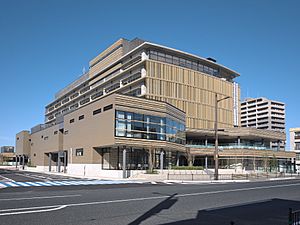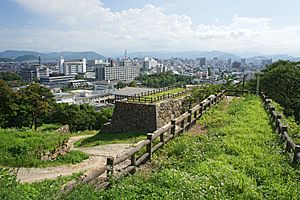Tottori (city) facts for kids
Quick facts for kids
Tottori
鳥取市
|
|||||||||||||
|---|---|---|---|---|---|---|---|---|---|---|---|---|---|
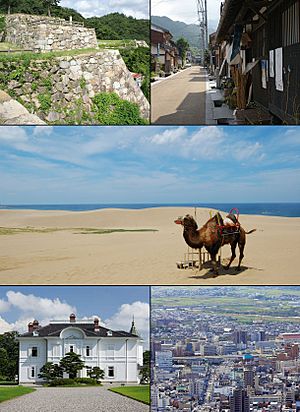
From top left: Tottori Castle, Shikano (old castle town), Tottori Sand Dunes, Jinpūkaku, View of Tottori from Tottori Castle
|
|||||||||||||
|
|||||||||||||
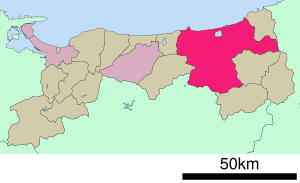 |
|||||||||||||
| Country | Japan | ||||||||||||
| Region | Chūgoku (Sanin) | ||||||||||||
| Prefecture | Tottori | ||||||||||||
| Area | |||||||||||||
| • Total | 765.31 km2 (295.49 sq mi) | ||||||||||||
| Population
(November 30, 2022)
|
|||||||||||||
| • Total | 183,383 | ||||||||||||
| • Density | 239.6192/km2 (620.611/sq mi) | ||||||||||||
| Time zone | UTC+09:00 (JST) | ||||||||||||
| City hall address | 116 Shutoku-cho, Tottori-shi, Tottori-ken 680-8571 | ||||||||||||
| Climate | Cfa | ||||||||||||
|
|||||||||||||
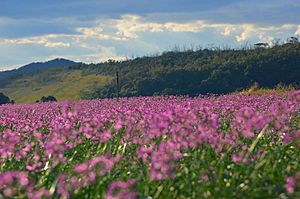
Tottori (鳥取市, Tottori-shi) is the main city and capital of Tottori Prefecture in Japan. It is located in the Chūgoku region. As of November 30, 2022, about 183,383 people lived in Tottori. The city covers an area of 765.31 square kilometers (295.49 sq mi). A large part of Tottori is within the San'in Kaigan Geopark, a special area recognized for its unique natural features.
Contents
Geography
Tottori is in the eastern part of the prefecture, near the Chūgoku Mountains. The Sendai River flows through the city. Tottori is about 300 kilometers (186 miles) from Hiroshima City. However, it is closer to other big cities like Kobe (180 km or 112 miles), Osaka (190 km or 118 miles), and Kyoto (220 km or 137 miles).
What are the Tottori Sand Dunes?
Tottori is most famous for its amazing Tottori Sand Dunes. These dunes are a very popular place for tourists to visit. They also serve as an important research center for growing crops in dry areas. Tottori University has an Arid Land Research Center here.
Neighboring Towns and Cities
Tottori shares borders with several other towns and cities:
- In Hyōgo Prefecture: Shin'onsen
- In Okayama Prefecture: Kagamino and Tsuyama
- In Tottori Prefecture: Chizu, Iwami, Misasa, Wakasa, Yazu, and Yurihama
What is the Climate Like in Tottori?
Tottori has a humid subtropical climate. This means it has hot summers and cool winters. It rains a lot throughout the year.
Demographics
Tottori's population has changed over the years. According to Japanese census data, Tottori has the smallest population among all prefectural capitals in Japan.
- In 1920, the population was about 130,050.
- By 1950, it grew to around 168,463.
- In 2000, it reached its highest at 200,744 people.
- By 2010, the population was 197,391.
History
Tottori has a long history. It was part of an old area called Inaba Province. The name "Tottori" was first written down in the early Heian period.
How did Tottori City Begin?
Tottori Castle was finished in 1545. The town that grew around this castle, called a jōkamachi, became the center of modern Tottori City. During the Edo period, the Ikeda clan ruled this area from Tottori Castle. Tottori officially became a city on October 1, 1889.
Important Events in Tottori's History
Tottori has faced some challenges:
- On September 10, 1943, a big earthquake, known as the 1943 Tottori earthquake, destroyed most of the downtown area. Over 1,000 people lost their lives.
- On April 17, 1952, a large fire, the Great Tottori Fire, destroyed much of the rebuilt city.
- In the 1950s and again in 2004, Tottori grew by merging with several nearby towns and villages. This process is called "gappei" in Japan. For example, on November 1, 2004, towns like Kokufu, Fukube, Aoya, Ketaka, Shikano, Kawahara, Mochigase, and the village of Saji joined Tottori.
- On October 1, 2005, Tottori gained "special city" status. This gave it more local control over its own affairs.
- In 2016, another earthquake, the 2016 Tottori earthquake, caused some damage and injuries, but no one died.
Economy
Tottori City is the main business hub for Tottori Prefecture. It is a center for trade and services. Farmers in Tottori grow rice and are also well-known for producing scallions.
Education
Tottori City has several places for learning, from elementary schools to universities.
Universities and Colleges
- Tottori University: This is a national public university. Its main campus is located near Koyama Lake.
- Tottori University of Environmental Studies: This is a private university. It is in the southeastern part of the city.
Schools for Younger Students
Tottori has many schools for children:
- 39 public elementary schools run by the city.
- 1 public elementary school run by the national government.
- 13 public middle schools run by the city.
- 1 public middle school run by the national government.
- 1 private middle school.
- 7 public high schools run by the Tottori Prefectural Board of Education.
- 4 private high schools.
- The prefecture also runs special education schools for students with disabilities.
Transportation
Getting around Tottori and to other places is easy with its airport, railways, and highways.
Airports
- Tottori Airport
Railway
The JR West operates two main lines through Tottori:
- Inbi Line: Connects Tottori to other areas.
- San'in Main Line: Runs along the coast, connecting Tottori to other cities.
Highways
Major roads connect Tottori to the rest of Japan:
 Tottori Expressway
Tottori Expressway San'in Expressway
San'in Expressway San'in Kinki Expressway
San'in Kinki Expressway- National Route 9
- National Route 29
- National Route 53
- National Route 373
Sister Cities
Tottori has special relationships with cities around the world and in Japan. These are called "sister cities" or "friendship cities."
 Cheongju, South Korea
Cheongju, South Korea Hanau, Germany
Hanau, Germany Himeji, Hyōgo, Japan (since 1972)
Himeji, Hyōgo, Japan (since 1972) Iwakuni, Yamaguchi, Japan (since 1995)
Iwakuni, Yamaguchi, Japan (since 1995) Kushiro, Hokkaido, Japan (since 1963)
Kushiro, Hokkaido, Japan (since 1963) Shahe, Hebei, China (friendship city since 1995)
Shahe, Hebei, China (friendship city since 1995) Taicang, Jiangsu, China (friendship city since 1995)
Taicang, Jiangsu, China (friendship city since 1995)
Local Attractions
Tottori has many interesting places to visit and things to do.
What Can You See in Tottori?
The city's main street, Wakasa Street, goes north from the train station. It ends at the foot of Kyushouzan mountain. This mountain area is the oldest part of the city.
- Tottori Castle: The ruins of this old castle are open to the public. The Castle Festival is held here every autumn.
- Around the mountain, you can find temples, museums, and public parks.
- Shan-shan festival: This famous summer festival features groups of people dancing with large, decorated umbrellas. The name "Shan-shan" comes from the sound of bells on the umbrellas.
- San In Beach Party: At the start of summer, Tottori hosts one of Japan's biggest beach parties, with popular DJs.
Museums to Explore
- Tottori City Historical Museum: Learn about the city's past.
- Tottori Folk Crafts Museum: See traditional crafts.
- Tottori Prefectural Museum: Discover more about the prefecture.
- Tottori Sand Museum: See amazing sculptures made of sand.
- Watanabe Art Museum: Enjoy various art collections.
Sports Facilities
- Axis Bird Stadium
- Yamata Sports Park Stadium
Shrines and Temples
- Kannon-in: Famous for its beautiful Japanese garden.
- Kōzen-ji: A family temple of the Ikeda Clan.
- Mount Misumi
- Ōchidani Shrine
- Ube shrine: An important old shrine.
Historical Sites
These places are protected as important parts of Japan's history:
- Aoyakamiji Site
- Fuse Kofun (ancient burial mound)
- Ifukibe-no-Tokotari grave
- Inaba Provincial Capital ruins
- Kajiyama Kofun (ancient burial mound)
- Tochimoto temple ruins
- Tottori Castle
- Tottori Domain Ikeda clan cemetery
Other Fun Places
- Jinpūkaku: A beautiful French Renaissance-style building once owned by the Ikeda clan.
- Shikano Castle
- Tottori Sand Dunes: The most famous natural attraction.
Culture
- Kaigara Bushi: A traditional folk song from the area.
See also
 In Spanish: Tottori (Tottori) para niños
In Spanish: Tottori (Tottori) para niños





